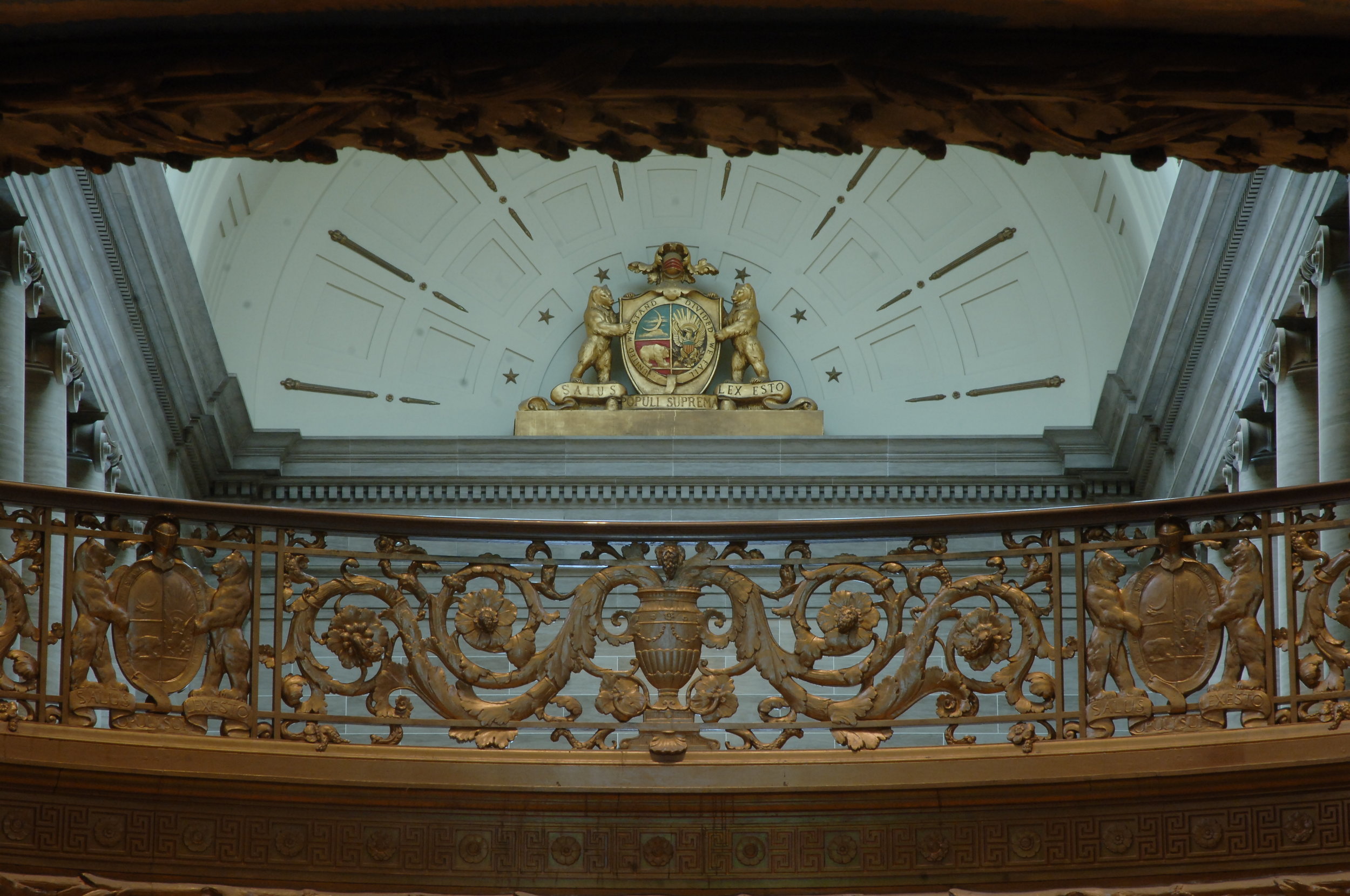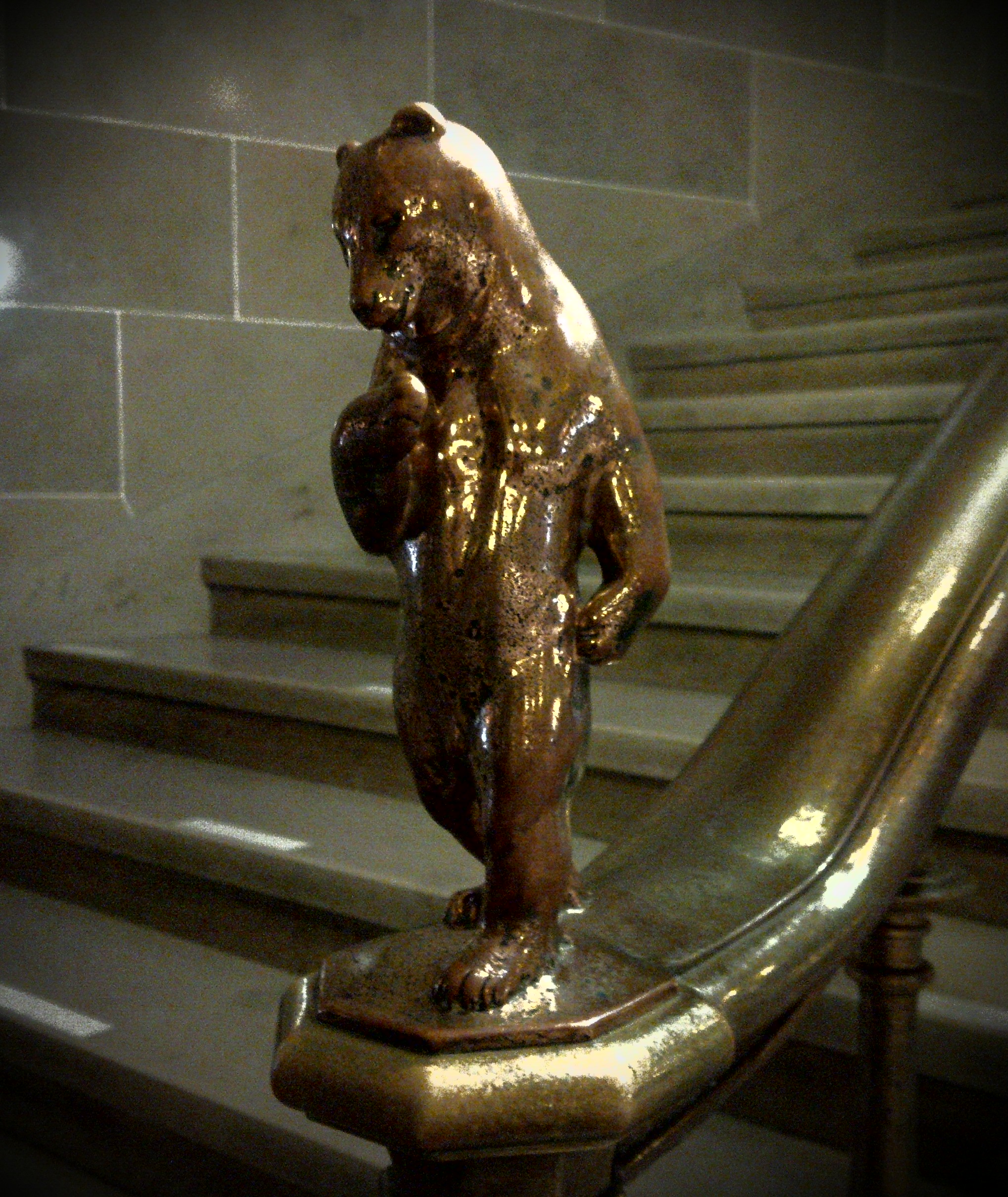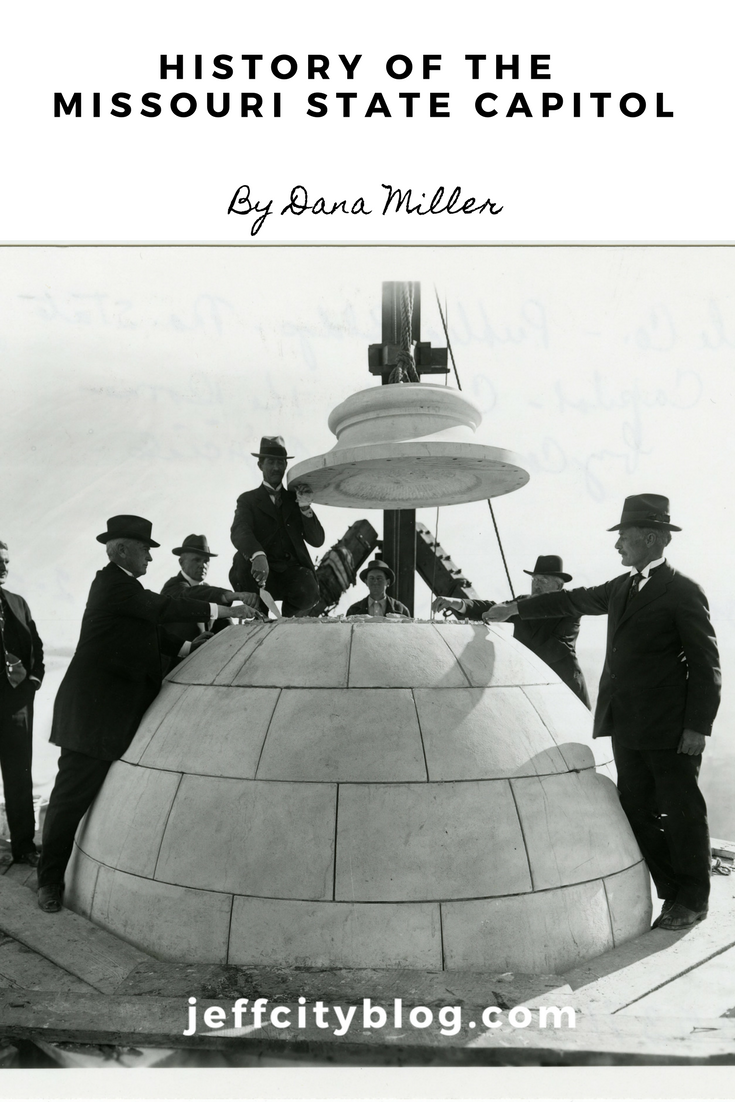Introducing guest contributor, Dana Miller - Assistant Chief Clerk for the Missouri House of Representatives. As the current chair of the Missouri State Capitol Commission, Dana has been a driving force behind the preservation of our capitol.
She's here to answer some of our questions about the history and symbolism behind the Capitol and tells us some of her favorite stories from within the Capitol walls. She also gives us an insider look into the reconstruction that is going on right now.
After the first capital in Jefferson City burned down and the second was struck by lightning, what were the most important features people wanted in the building we have now?
Yes, considering our past experiences with fire, it was obvious that the new capitol would need to be a “fireproof” building—so it was constructed primarily of stone, masonry, and steel. The legislature also stipulated that, when possible, the new capitol would be built of materials native to Missouri. So our “Missouri-made” capitol was constructed from a form of Burlington limestone that was quarried extensively near Carthage and to a lesser extent, Springfield, Missouri. Coincidentally, this stone polishes beautifully, which is why it is commonly referred to "Carthage Marble." To this day, it clads the exterior and comprises the walls and floors of much of the interior areas of the building. If you've ever toured the Capitol, you have walked on that marble and probably have observed the small fossils embedded in it—a reminder that our marble is actually sedimentary rock. The school kids love looking for these little relics of the past when they visit.
Location was another important feature relating to the new capitol. Even prior to the 1911 fire, there had been an ongoing movement to relocate the state capital to another part of the state. The 1840 structure was considered inadequate within decades of its construction and had undergone some clumsy expansion efforts in the 1880s. Others were critical of the City of Jefferson itself—the town really was considered a rough and provincial backwater. Looking back, our little capital city was admittedly humble compared to the more metropolitan areas of the state. Thankfully, at a special election held on August 1, 1911, the state's voters overwhelmingly rejected the “Capital Removal Scheme” when they approved the construction of a new building—in Jefferson City. By a three-to-one margin, the people of Missouri permanently laid to rest the question of the location of the seat of state government.
What is your favorite story about the capitol building? OR What is your favorite story about something that happened inside the capitol building?
As a legislative staffer, I have to say that one of my favorite stories about the building relates to my role as a member of the Missouri State Capitol Commission, which is tasked with ensuring the integrity of the building and its art.
Our capitol was constructed during the years of World War I. The U.S. economy was thriving, and the tax levy that was approved by the voters in 1911 for the construction of the building generated more revenue than was needed—so we had a surplus of funds left over following the completion of the capitol. The general assembly wanted to spend those funds on any number of projects totally unrelated to the building—but thankfully the attorney general at the time opined that the funds approved by the voters for the capitol's construction must be used on the capitol. Approximately $1 million was spent over the next 11 years to fill the building and grounds with the stellar collection of murals, stained glass, statuary, and fountains that we enjoy today. That was a huge amount of money in those days—especially considering the structure cost between $3.5-4 million to construct. The decoration project is an entire tale unto itself, and if you visit other state capitols, you'll understand why this story matters. There may be a few buildings that are more elaborate (although many are not), but I don't think you could find another statehouse more extensively decorated with quality art than ours.
I also love reading about the public input and sentiment that was expressed at the time of the building's construction. People were prone to more poetic and extravagant prose, which speaks to me, personally, in my role to preserve this building. For example, during the movement to relocate the capital, propaganda was waged on both sides. Those in favor of retaining Jefferson City published large posters warning the citizens to“Vote Against Capital removal because it is unnecessary, unjust…and the State will in no sense be a gainer by the change.” Likewise, a Columbia resident expressed his support in adopting a motto "Upward and Onward,”not “Down and Backward.” The chairman of the Capitol Commission Board expressed it best when he said that the board had "consecrated themselves to the task of building a monument to the glory of Missouri." I think their mission was accomplished.
What are the most symbolic parts of the capitol? For example, I heard that the symmetry of the building symbolizes equal weight to both the House and Senate.
Oh yes, the building is full of symbols--some obvious and others not so much. The length of the east and west wings perfectly balances the height of the dome. And the central rotunda that lies beneath the dome serves as the common ground that is a symbolic "neutral zone" between the House, Senate, and the Executive (Governor). There are also many small symbols—medallions that resemble the state floral emblem (the Hawthorn) adorn the balusters on the staircases. The acorn and acanthus leaves—symbols which represent strength, longevity, and endurance—are found in the decorative wooden, plaster, and stone carvings throughout the building. These are just a few examples—we actually have a scavenger hunt based on all of the symbols and monuments that really gets visiting school kids engaged in learning about the building.
The acorn and acanthus leaves represent strength, longevity, and endurance.
Speaking of the symmetry of the building—as mentioned, ours is beautifully balanced and reflects the talent of the original architects, Evarts Tracy and Egerton Swartwout. Their prominent New-York-based firm was not from Missouri—which caused a bit of a stir. But when you look at the plans that were submitted in the contest that was held to select the building design—there was no comparison. We are so fortunate that we have the building this firm designed. It is truly a work of art.
What is your favorite piece of art in the capitol and why?
This is a hard question to answer because there is such an abundance of quality art! I have many favorites, and at the top of the list are the well-known works by Sir Frank Brangwyn (rotunda murals) and Thomas Hart Benton’s infamous and fabulous A Social History of Missouri panoramic murals in the House Lounge.
But there are many others located throughout the building that also wonderful but are sometimes overlooked. The Civil War half-moon shaped (“lunette”) paintings by N.C. Wyeth (famous illustrator, and father of the renowned artist Andrew Wyeth) are action-filled representations of the Battle of Wilson's Creek and the Battle of Westport. The smaller pendentive domes that flank the third-floor rotunda are also home to dozens of murals that we refer to as the "occupation murals" because they depict various trades and professions of Missouri workers. They were painted by Allen Tupper True, who came to Missouri to supervise the installation of the large rotunda murals but was a fantastic artist in his own right.
The four mural panels in the Senate Chamber depicting landmark events in the state’s history by Richard E. Miller are gorgeous—the technique is a blend of traditional realism but also containing a serene quality that hints that the artist was influenced by the impressionist masters who were his contemporaries.
Finally, the Capitol Decoration Commission found some hidden talent in a colony of artists from in an unlikely place—New Mexico. The Taos Society of Artists produced some spectacular lunette images depicting the social history of Missouri, including representations of the native people of Missouri prior to settlement. I've read that the Commission was running low on funds and they were able to affordably secure the commissions for these works. I'd speculate that some (not all) of the artists might have been in the starving category, but it really was a great arrangement. The Commission got a good deal on the artwork, and these artists had firsthand experience with the native peoples of New Mexico, which influenced their art in a remarkable way. Some of my favorites are located on the northeast corridor of the second floor include E. L. Blumenschein’s Trader at Fort Carondelet and Osage hunters and village scenes by E. I. Couse.
These are just some of my favorite paintings—we haven’t even gotten to the stained glass or the statuary and our fountains outside the building!
If someone has already taken the standard tour of the capitol, and they want to learn more, what would you suggest they do?
Buy Bob Priddy and Jeffrey Ball’s book The Art of the Missouri Capitol: History in Canvas, Bronze and Stone. It's full of photos and the stories behind the art that adorns the building. The Missouri State Capitol Commission helped raise funds to publish that book and it is a tribute to the art and the artists whose work decorates our state capitol. For those who are seriously interested in reading about the capitol building, I would also recommend finding a copy of the reports of the original Missouri Capitol Commission Board (published 1919) and the Capitol Decoration Commission (published 1928). Without these two groups, we would not have this Capitol. (Copies of the books sometimes will surface on eBay or Amazon, and they are also available through the Legislative Library, which is located in the Capitol.)
The Secretary of State published a nice history of the development of the capitol and the Capital City in the 2001 Missouri Manual. It is an easy read and is available online: The City of Jefferson - The Permanent Seat of Government.
Veteran statehouse reporter and historian Bob Priddy is currently putting the finishing touches of a comprehensive history (a “biography”) of the state capital. This book will focus on the how the seat of government came to be in Jefferson City, and then the struggle for the building to stay there. The Commission is excited to once again assist with the publishing costs and it hopefully will be published within the next year. So stay tuned…
What is an interesting historical fact that most people do not know about the capitol?
An interesting thing we learned recently was that the capitol whispering gallery was the very first to be to be specifically designed to be a whispering gallery. I know of two other capitols that have such galleries—Texas and the United States Capitol. Both were whispering galleries by chance—the curved surface of a dome can create the acoustics conducive to hearing a “whisper” from across the room. But our whispering gallery was actually designed for this purpose, which I think is pretty cool.
What is your favorite part of the captol building and why?
That is not a fair question! There are too many areas and features to mention, so I will focus one area that encompasses the entire building. Some of the first decorations added to the building were the Latin and English inscriptions that are etched on the building's façade and within its interior. The original commission carefully chose them after touring other state capitol buildings and I think they serve as a silent but noble reminder to the elected officials who work within
· Be Just and Fear Not (exterior - east entrance)
· Not to Be Served But to Serve (interior - Senate chamber entrance)
· Salus Populi Suprema Lex Esto; translated - Let the welfare (or good) of the people be the supreme law.
This is our state motto, and it is inscribed on the state seal and also on the south pediment facing the Supreme Court Building.
What are future changes we should expect with the capitol building?
The capitol is now into its 100th year of operation, and we recently completed a series of centennial celebratory events highlighting milestones in the building’s construction. During this time, the Capitol Commission has stressed the need to protect, repair, and restore the building. As one legislator recently stated, this aging building doesn’t just need a facelift—it needs a transformation.
Thankfully, after years of deferred maintenance, we have invested funds to repair the water leaks and to address some of the resulting environmental issues in the lower level of the building. Currently, the exterior stone is being repaired—you might have noticed that the area around the building has become a construction zone. This project will take over two years to complete—some of the stone had deteriorated to the point that it was literally crumbling and it was becoming a safety hazard to walk near the building due to threat of a piece of rock falling off—so there is a lot of work to be done to fix those issues.
While we are fixing the exterior, we still have much to do to the interior spaces of the building. It was constructed at a time when we were not sensitive to ensuring accessibility to all—so we have many areas, including offices of elected officials—that are not accessible to some individuals. The infrastructure and mechanical systems are also aging and need to be updated. All of these items are part of determining what our vision is for the future of this great building. I’m confident that as the people of Missouri did in 1911, we will likewise ensure that this our State Capitol will be preserved and ready for the next 100 years of operation.
Did you like this post? Tell us what you think in the comments! If you have any questions, feel free to ask them there as well. We'll do our best to answer!
Pin this image:
Friend who makes this post possible:
















